Overview
To strengthen deep core muscles, individuals should focus on exercises like the transverse abdominis activation, bird-dog, plank, and dead bug, which enhance stability and coordination. The article supports this by detailing how these exercises effectively engage key muscle groups essential for core strength, ultimately leading to improved posture, reduced injury risk, and enhanced athletic performance.
Introduction
In the pursuit of optimal health and performance, the importance of deep core muscles cannot be overstated. These hidden powerhouses, including the transverse abdominis, multifidus, diaphragm, and pelvic floor muscles, play a crucial role in stabilizing the spine and pelvis, influencing everything from posture to athletic performance. Recent studies reveal that strengthening these muscles not only enhances physical capabilities but also contributes to emotional well-being and workplace productivity.
As organizations increasingly recognize the link between employee health and performance, prioritizing core strength training can pave the way for improved motivation, reduced injury risks, and a more dynamic workforce. This article delves into the anatomy of deep core muscles, effective exercises for strengthening them, and the myriad health benefits that come from a well-rounded core training routine. Embracing these insights can empower individuals to take charge of their fitness journey and cultivate a stronger, healthier core.
Understanding Deep Core Muscles: Anatomy and Importance
Deep core structures, comprising the transverse abdominis, multifidus, diaphragm, and pelvic floor components, are vital for providing stability and support to the spine and pelvis. According to McGill & Marshall (2012), the participants in their study averaged 25.60 ± 3.40 years, highlighting the relevance of these findings to a younger, active population. These tissues are essential not only for maintaining proper posture but also for facilitating movement in everyday activities and athletic performance.
The incorporation of shoulder movements during leaning-forward activities has been demonstrated to enhance EMG activity in the internal oblique and multifidus groups, highlighting the significance of including such movements in workout regimens. The most recent studies highlight the essential roles of these groups; for instance, the transverse abdominis is vital for stability of the torso, while the pelvic floor structures aid the pelvic organs and enhance overall strength. A case study comparing seven trunk stability exercises demonstrated that the bird dog and side plank exercises performed with the hollowing maneuver resulted in the greatest increase in tissue thickness, emphasizing the effectiveness of specific training methods.
By reinforcing these tissues, you can significantly boost your central strength, which is crucial for understanding how to strengthen deep core muscles, resulting in enhancements in both physical health and athletic abilities. Recognizing the structure of these tissues enables you to appreciate the importance of including focused exercises on how to strengthen deep core muscles in your fitness routine. As J.M.M.
aptly noted,
The level of evidence of the included studies was mainly moderate, suggesting that more high-quality research is needed to reduce bias and draw solid conclusions about essential body activity.
This emphasizes the significance of being knowledgeable about the latest discoveries as you create effective training programs that teach how to strengthen deep core muscles, ultimately paving the way for improved posture, movement efficiency, and injury prevention.
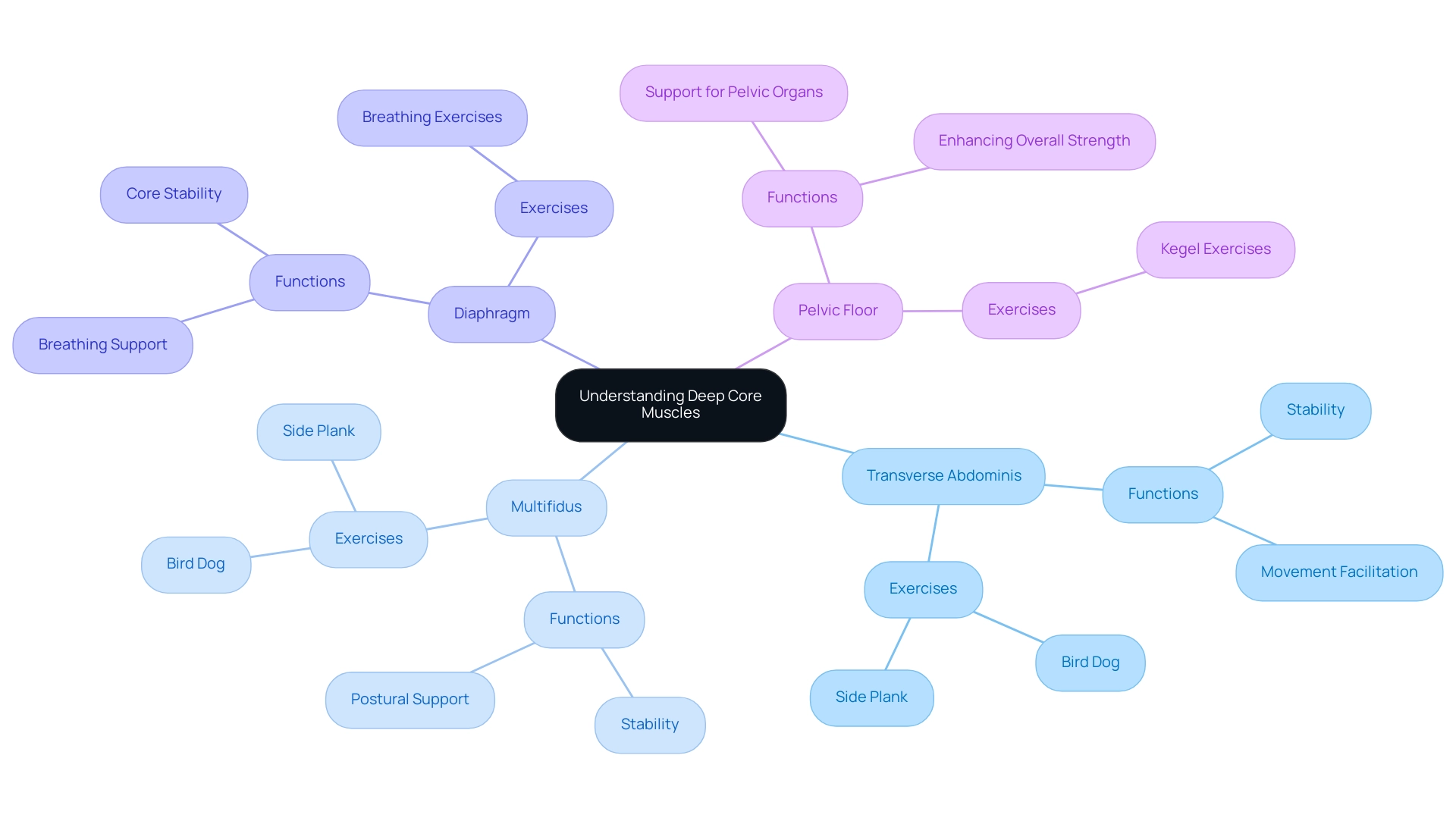
Effective Exercises for Strengthening Your Deep Core
- Transverse Abdominis Activation: Begin by lying on your back with your knees bent, creating a stable base. Inhale deeply, then exhale while gently drawing your belly button towards your spine. This simple yet powerful movement is an effective way to learn how to strengthen deep core muscles by engaging your deep abdominal muscles. Hold this position for 5 seconds, focusing on the contraction, and repeat for a total of 10 times. This activity not only enhances the transverse abdominis but also demonstrates how to strengthen deep core muscles, preparing the foundation for better stability in the midsection.
- Bird-Dog: Position yourself on all fours, ensuring your hands are directly under your shoulders and knees under your hips. Extend your right arm forward while simultaneously extending your left leg backward, maintaining balance and alignment. Hold this position for 5 seconds before returning to the starting position and switching sides. Aim for 10 repetitions on each side. The bird-dog movement is outstanding for improving coordination and trunk stability, which is essential for understanding how to strengthen deep core muscles for anyone participating in recreational activities or rehabilitation programs. Recent studies indicate that including this activity can lead to notable enhancements in stability of the center, with an average decrease in pain of 3.08 noted in individuals involved in stabilization programs.
- Plank: Lie face down and lift your body off the ground, balancing on your forearms and toes. Ensure your body forms a straight line from head to heels. Maintain this position for 20-30 seconds, concentrating on your breath and the activation of your abdominal muscles. Gradually increase the duration as your strength improves. The plank is a fundamental activity that demonstrates how to strengthen deep core muscles, developing endurance and strength throughout the whole midsection, enhancing overall fitness and preventing injuries.
- Dead Bug: Lie on your back with your arms extended toward the ceiling and knees bent at 90 degrees. Slowly lower your right arm and left leg towards the floor while keeping your back flat against the ground. Return to the starting position and switch sides. Repeat this for 10 times on each side. The dead bug activity is especially beneficial for teaching how to strengthen deep core muscles, enhancing coordination and strength in the deeper layers of the torso and providing a solid base for all functional movements.
Integrating these activities into your routine can help you learn how to strengthen deep core muscles, resulting in notable advancements in torso strength and stability, which are vital for both performance and injury recovery. As emphasized by recent research, effective central training not only improves physical abilities but also aids in overall wellness, with an average decrease in discomfort noted in individuals participating in stabilization exercises. However, it’s important to highlight that the relevance of the research is mainly restricted to trained individuals, and there is a necessity for additional longitudinal investigations to draw solid conclusions about fundamental physical activity.
As J.M.M. stated, "the level of evidence of the included studies was mainly moderate, which suggests that more high-quality research is necessary in order to reduce the risk of bias and draw solid conclusions about essential muscle activity." This highlights the significance of continuing to explore effective fundamental strengthening workouts.
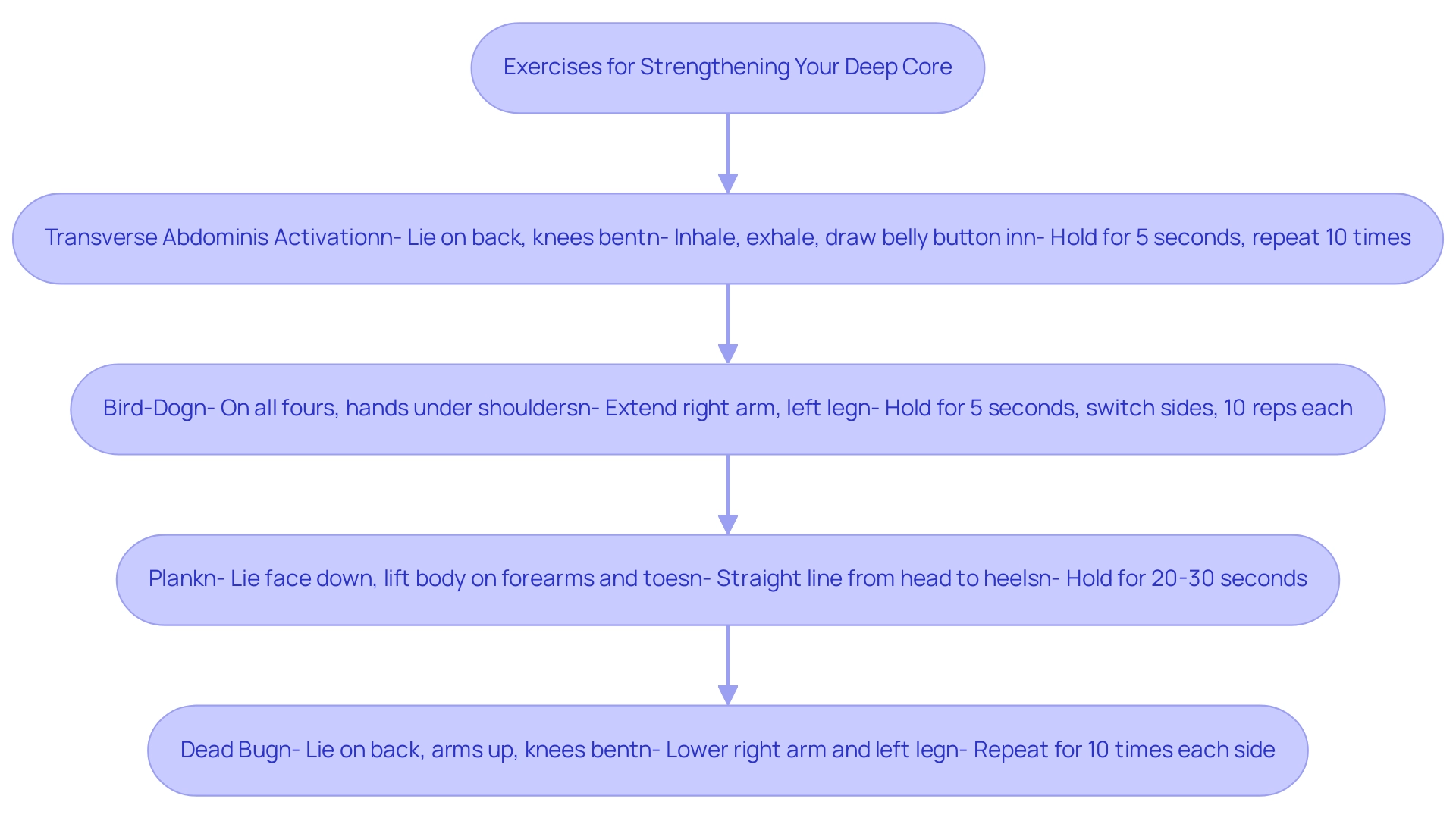
The Health Benefits of a Strong Deep Core
Building a strong deep foundation is essential not only for enhancing posture but also for alleviating back pain and minimizing injury risks, which are important aspects of how to strengthen deep core muscles—benefits that translate directly into the workplace. As health expert Wendi Weimar states, 'Understanding how to strengthen deep core muscles is important because the central muscles stabilize the center of the body, allowing the muscles of the appendicular skeleton to pull against a stable platform.' This stability is crucial for athletic performance and daily tasks, as it teaches employees how to strengthen deep core muscles, enabling them to maintain better balance and reducing fatigue.
Moreover, research shows that workers who participate in consistent physical activity, such as strength training for at least 30 minutes three times a week, report greater levels of motivation and emotional health—crucial elements that improve workplace performance. Additionally, participation in exercise programs has been linked to a reduction in absenteeism and presenteeism, further emphasizing the importance of regular physical activity. Recent statistics indicate that fundamental training sessions can vary from 7 to 60 minutes, offering flexibility to accommodate different schedules.
This training is particularly effective for adults aged 65 and older, significantly helping to mitigate fall risks. By emphasizing these substantial health benefits and linking them to workplace health initiatives, HR Benefits Managers can inspire individuals to commit to their fundamental training routines, ultimately leading to improved motivation, emotional well-being, and overall quality of life.
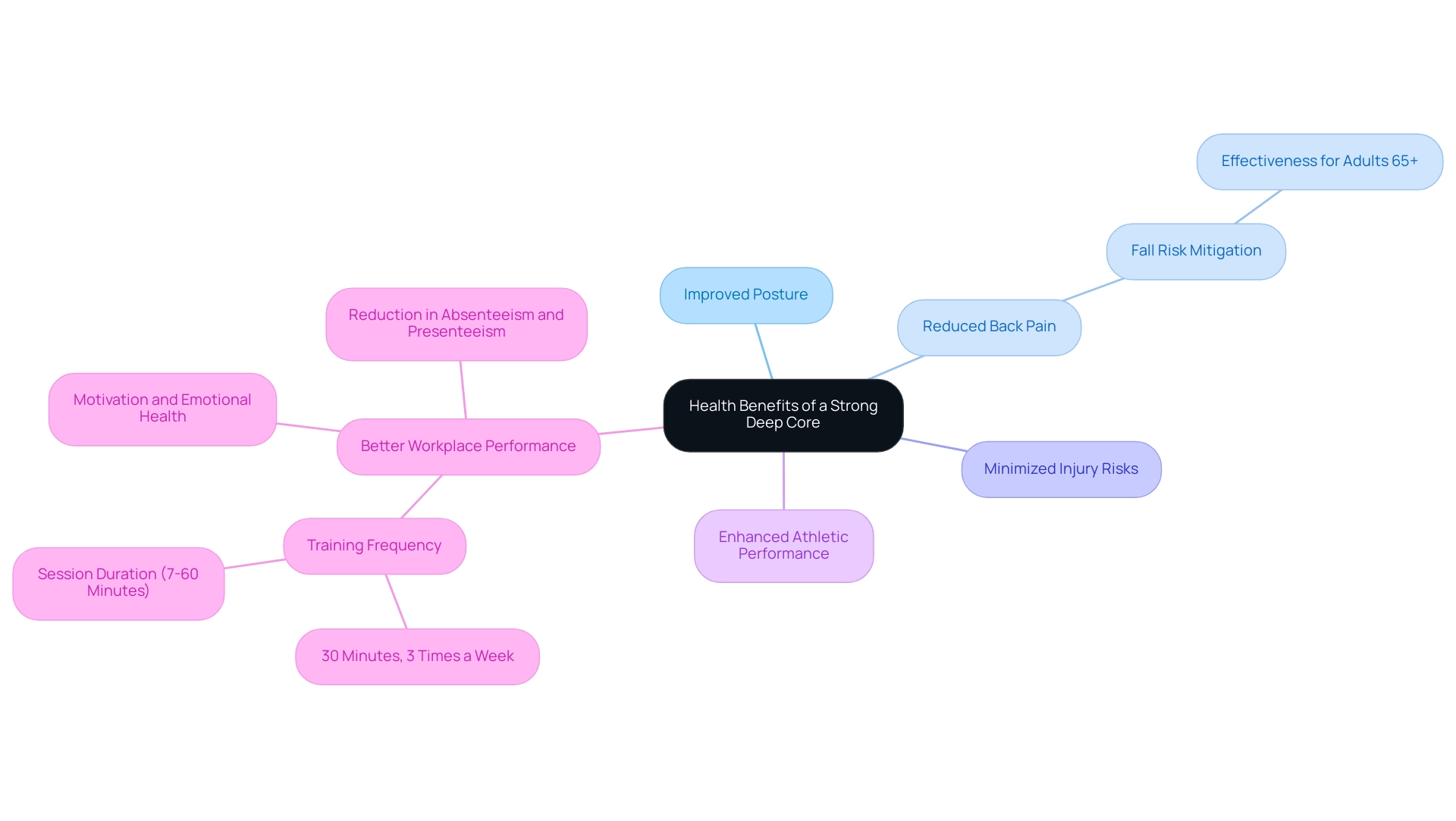
Challenges and Considerations in Deep Core Training
To understand how to strengthen deep core muscles effectively, a commitment to proper technique is required to prevent injuries and maximize benefits. Research emphasizes an urgent requirement for additional high-quality studies on central body activation, especially among varied populations, to enhance the understanding of effective training techniques. Many individuals face challenges such as difficulty in engaging the right muscles and maintaining correct form during workouts.
Statistics suggest that improper foundational training techniques can lead to significant injury rates, underscoring the importance of proper technique and injury prevention. To tackle these hurdles, begin with foundational movements that promote awareness and control before gradually advancing to more complex activities. Collaborating with a fitness professional can provide invaluable guidance—much like federated learning, which combines data from multiple institutions to enhance outcomes, working with experts ensures that your technique is sound.
It’s also vital to listen to your body; if you encounter any discomfort, take a moment to reassess your form and make necessary adjustments. Remember, consistency is your ally in this journey—set realistic goals and take pride in celebrating small victories along the way. Doing so not only encourages a positive mindset but also strengthens dedication to your fitness journey, ultimately resulting in a more robust, health center.
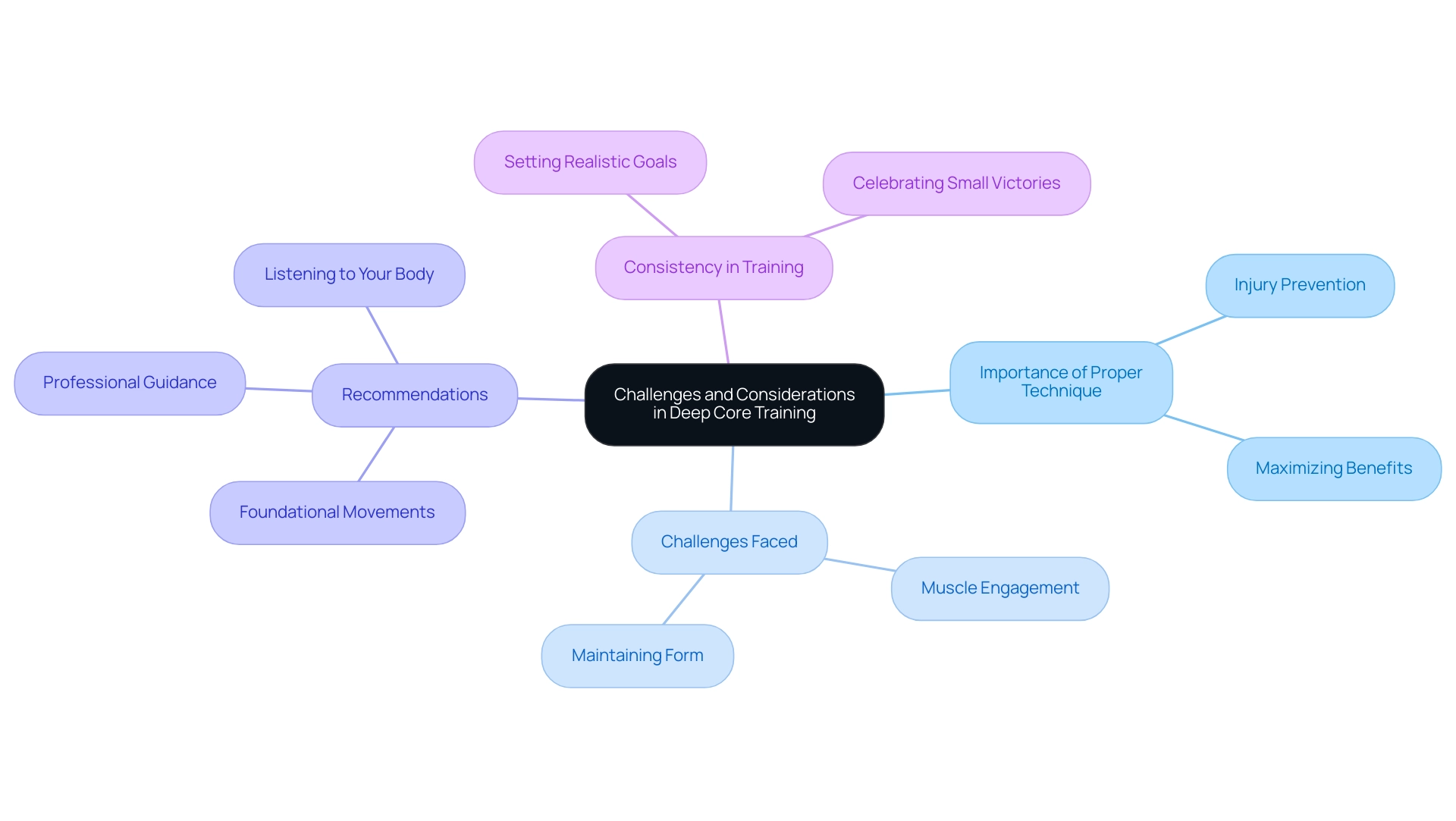
Incorporating Deep Core Exercises into Your Daily Routine
Incorporating exercises that focus on how to strengthen deep core muscles into your daily routine can be both manageable and rewarding. Start with short sessions, dedicating just 5-10 minutes, which can easily fit into your day. Consider incorporating these activities into your morning routine, during work breaks, or even while unwinding in front of the TV.
To boost your consistency, utilize reminders or establish specific times for your workouts. Research indicates that merely 24.2% of adults aged 18 and above satisfy the Physical Activity Guidelines for both aerobic and muscle-strengthening activities, emphasizing the significance of incorporating physical activity into daily life. Additionally, 30% of adults report feeling less stressed after exercising, with 62% of those finding it effective, according to the case study 'Exercise and Stress Statistics.'
Fitness expert Alyssa Sparacino notes, 'The percentage of exercisers who say they feel less stress after a workout varies by generation,' which underscores the varying impacts of exercise on stress relief. Engaging in a fitness class or partnering with a workout buddy can further enhance your commitment and accountability. Remember, the key to success is consistency—aim for at least three sessions a week.
This approach not only builds your core strength but also demonstrates how to strengthen deep core muscles, cultivating a habit that can lead to lasting benefits in your overall well-being.
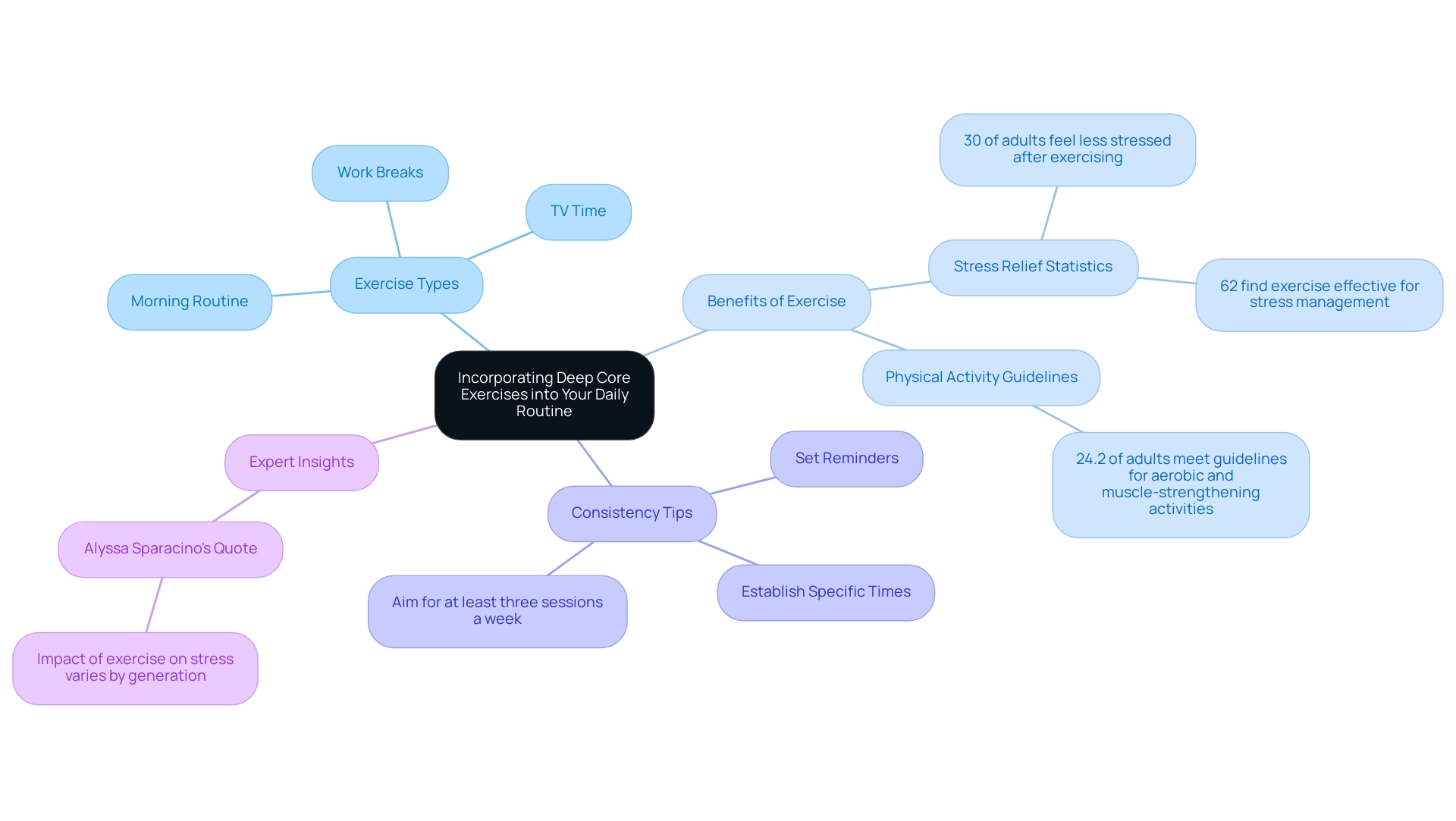
Conclusion
Deep core muscles are not just the foundation for physical stability; they are essential for enhancing overall health, performance, and workplace productivity. By understanding their anatomy and significance, individuals can appreciate the necessity of targeted exercises that strengthen these crucial muscle groups. Effective movements like the transverse abdominis activation, bird-dog, plank, and dead bug serve as practical tools to build core strength, improve posture, and alleviate back pain, ultimately leading to a more robust and resilient body.
The benefits of a strong deep core extend beyond physical capabilities. Regularly engaging in core training not only boosts motivation and emotional well-being but also reduces absenteeism in the workplace, creating a healthier, more dynamic work environment. As organizations acknowledge the direct link between employee health and performance, prioritizing core strength training becomes a strategic investment in their workforce's vitality.
While challenges in core training exist, such as maintaining proper technique and engaging the right muscles, commitment to consistent practice and gradual progression can lead to remarkable improvements. By incorporating deep core exercises into daily routines, individuals can foster a habit of fitness that pays dividends in both personal and professional spheres. Embracing this journey towards a stronger core is not just about physical transformation; it’s about empowering oneself to achieve greater well-being and fulfillment in all aspects of life.
Frequently Asked Questions
What are deep core structures and why are they important?
Deep core structures include the transverse abdominis, multifidus, diaphragm, and pelvic floor components, which are essential for providing stability and support to the spine and pelvis, maintaining proper posture, and facilitating movement in everyday activities and athletic performance.
What age group was involved in the study by McGill & Marshall (2012)?
The participants in the study averaged 25.60 ± 3.40 years, indicating the relevance of the findings to a younger, active population.
How can shoulder movements impact core stability during exercise?
Incorporating shoulder movements during leaning-forward activities has been shown to enhance EMG activity in the internal oblique and multifidus groups, highlighting the importance of including such movements in workout regimens.
Which exercises are most effective for increasing tissue thickness in core training?
A case study found that the bird dog and side plank exercises performed with the hollowing maneuver resulted in the greatest increase in tissue thickness, emphasizing the effectiveness of these specific training methods.
What benefits can be gained from reinforcing deep core tissues?
Reinforcing these tissues can significantly boost central strength, improve posture, enhance movement efficiency, and aid in injury prevention.
What is the current state of research on core strengthening exercises?
The level of evidence from the included studies is mainly moderate, suggesting a need for more high-quality research to reduce bias and draw solid conclusions about essential body activity.
What are some exercises recommended for strengthening deep core muscles?
Recommended exercises include: 1. Transverse Abdominis Activation: Lying on your back, inhale deeply, then exhale while drawing your belly button towards your spine. 2. Bird-Dog: On all fours, extend one arm and the opposite leg while maintaining balance. 3. Plank: Lift your body off the ground on your forearms and toes, forming a straight line. 4. Dead Bug: Lying on your back, lower one arm and the opposite leg while keeping your back flat.
What is the significance of including focused exercises for deep core muscles in fitness routines?
Including focused exercises helps strengthen deep core muscles, leading to improvements in physical health, athletic abilities, and overall wellness, while also reducing discomfort in individuals participating in stabilization exercises.

